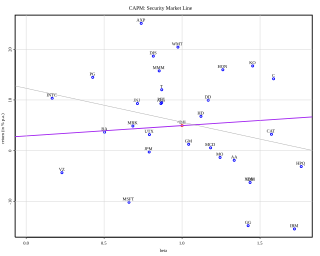
In finance,the capital asset pricing model (CAPM) is a model used to determine a theoretically appropriate required rate of return of an asset,to make decisions about adding assets to a well-diversified portfolio.
Active management is an approach to investing. In an actively managed portfolio of investments,the investor selects the investments that make up the portfolio. Active management is often compared to passive management or index investing.
Momentum investing is a system of buying stocks or other securities that have had high returns over the past three to twelve months,and selling those that have had poor returns over the same period.

Robeco is an originally Dutch asset management firm,since 2013 part of Orix,founded in 1929 as the Rotterdamsch Beleggings Consortium. As of 2014,the company had €246 billion of assets under management. It was acquired in 2001 by the Rabobank Groep and sold in 2013 to ORIX Corporation.
Benchmark-driven investment strategy is an investment strategy where the target return is usually linked to an index or combination of indices of the sector or any other like S&P 500.
In asset pricing and portfolio management the Fama–French three-factor model is a statistical model designed in 1992 by Eugene Fama and Kenneth French to describe stock returns. Fama and French were colleagues at the University of Chicago Booth School of Business,where Fama still works. In 2013,Fama shared the Nobel Memorial Prize in Economic Sciences for his empirical analysis of asset prices. The three factors are (1) market excess return,(2) the outperformance of small versus big companies,and (3) the outperformance of high book/market versus low book/market companies. There is academic debate about the last two factors.
Goals-Based Investing or Goal-Driven Investing is the use of financial markets to fund goals within a specified period of time. Traditional portfolio construction balances expected portfolio variance with return and uses a risk aversion metric to select the optimal mix of investments. By contrast,GBI optimizes an investment mix to minimize the probability of failing to achieve a minimum wealth level within a set period of time.
A quantitative fund is an investment fund that uses quantitative investment management instead of fundamental human analysis.
Portfolio optimization is the process of selecting the best portfolio,out of the set of all portfolios being considered,according to some objective. The objective typically maximizes factors such as expected return,and minimizes costs like financial risk. Factors being considered may range from tangible to intangible.
Clifford Scott Asness is an American hedge fund manager and the co-founder of AQR Capital Management. According to an April 2020 Forbes profile,Asness' estimated net worth was $2.6 billion.
Quantitative analysis is the use of mathematical and statistical methods in finance and investment management. Those working in the field are quantitative analysts (quants). Quants tend to specialize in specific areas which may include derivative structuring or pricing,risk management,investment management and other related finance occupations. The occupation is similar to those in industrial mathematics in other industries. The process usually consists of searching vast databases for patterns,such as correlations among liquid assets or price-movement patterns.

In investing and finance,the low-volatility anomaly is the observation that low-volatility stocks have higher returns than high-volatility stocks in most markets studied. This is an example of a stock market anomaly since it contradicts the central prediction of many financial theories that taking higher risk must be compensated with higher returns.
Factor investing is an investment approach that involves targeting quantifiable firm characteristics or “factors”that can explain differences in stock returns. Security characteristics that may be included in a factor-based approach include size,low-volatility,value,momentum,asset growth,profitability,leverage,term and cost of carry.
The volatility tax is a mathematical finance term,formalized by hedge fund manager Mark Spitznagel,describing the effect of large investment losses on compound returns. It has also been called volatility drag,volatility decay or variance drain. This is not literally a tax in the sense of a levy imposed by a government,but the mathematical difference between geometric averages compared to arithmetic averages. This difference resembles a tax due to the mathematics which impose a lower compound return when returns vary over time,compared to a simple sum of returns. This diminishment of returns is in increasing proportion to volatility,such that volatility itself appears to be the basis of a progressive tax. Conversely,fixed-return investments appear to be "volatility tax free".

Peter C. Oppenheimer is chief global equity strategist and head of Macro Research in Europe within Global Investment Research at Goldman Sachs. Oppenheimer joined Goldman Sachs in 2002 as European and global strategist and was named managing director in 2003 and partner in 2006. He regularly appears in news outlets such as Financial Times,CNBC,The Guardian,The Independent,Bloomberg,and Barron’s among others as a finance strategist and expert.
Low-volatility investing is an investment style that buys stocks or securities with low volatility and avoids those with high volatility. This investment style exploits the low-volatility anomaly. According to financial theory risk and return should be positively related,however in practice this is not true. Low-volatility investors aim to achieve market-like returns,but with lower risk. This investment style is also referred to as minimum volatility,minimum variance,managed volatility,smart beta,defensive and conservative investing.
Conservative formula investing is an investment technique that uses the principles of low-volatility investing and is enhanced with momentum and net payout yield signals.
Pim van Vliet is a Dutch fund manager and head of conservative equities at Robeco Quantitative Investments.
Guido Baltussen is a Dutch economist who is professor in Behavioral Finance at Erasmus University Rotterdam and Head of Factor Investing and co-head of Quant Fixed Income at Robeco Asset Management.



